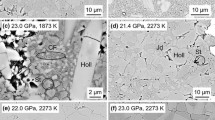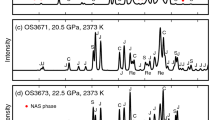Abstract
The phase K2Mg5Si12O30 was synthesized both hydrothermally and dry under a variety of pressures and temperatures, and its stability relations were determined. Under hydrothermal conditions it exhibits a lower stability limit lying at 595°C, 1 kb, and 650°C, 2 kb, due to its breakdown into the hydrous assemblage quartz+KMg2.5Si4O10(OH)2 (a mica phase). Its upper temperature stability under hydrothermal conditions is given by its incongruent melting to MgSiO3+liquid. Near 820° C at a fluid pressure of approximately 6.5 kb the two univariant curves for these breakdown reactions intersect thus limiting the stability field to lower fluid pressures. — Under anhydrous conditions K2Mg5Si12O30 becomes unstable at pressures between approximately 7 and 32.5 kb due to its incongruent melting to the assemblage MgSiO3+quartz (or coesite)+liquid; this melting curve has a pronounced negative slope. No subsolidus breakdown assemblage was encountered at 32.5 kb down to temperatures as low as 750°C. This behavior is probably due to the instability of other ternary compounds in the system K2O-MgO-SiO2 at high pressures and thus to the existence of very low-temperature eutectics involving only binary and unary solid phases plus liquid.
It is likely that these stability relations provide a model for those of the natural minerals merrihueite and roedderite which contain Na and Fe+2 partly substituting for K and Mg and which were encountered in several meteorites. Therefore, the cosmic events leading to the formation of these minerals must have taken place at relatively low pressures and high temperatures, especially when water was present. The bulk compositions of these minerals appear to be incompatible with average chondritic matter under equilibrium conditions. Hence merrihueite and roedderite are not likely to be found in equilibrated chondrites which contain feldspars instead.
Similar content being viewed by others
References
Ahrens, L. H.: Si-Mg fractionation in chondrites. Geochim. Cosmochim. Acta 28, 411–423 (1964).
—: Observations on the Fe-Si-Mg relationships in chondrites. Geochim. Cosmochim. Acta 29, 801–806 (1965).
Boström, K., and K. Fredriksson: Surface conditions of the Orgueil meteorite parent body as indicated by mineral associations. Smithsonian Misc. Coll. 151, No. 3, 1–39 (1966).
Boyd, F. R.: Geological aspects of high-pressure research. Science 145, 13–20 (1964).
Dodd, R. T., R. W. van Schmus, and U. B. Marvin: Merrihueite, a new alkali-ferro-magnesium silicate from the Mezö-Madaras chondrite. Science 149, 972–974 (1965).
Ernst, W. G.: The stability relations of magnesioriebeckite. Geochim. Cosmochim. Acta 19, 10–40 (1960).
French, B. M., and H. P. Eugster: Experimental control of oxygen fugacities by graphite-gas equilibrium. J. Geophys. Res. 70, 1529–1539 (1965).
Fuchs, L., C. Frondel, and C. Klein: Roedderite, a new mineral from the Indarch meteorite. Am. Mineralogist 51, 949–955 (1966).
Goldstein, J. I., and J. M. Short: The iron meteorites, their thermal history and parent bodies. Geochim. Cosmochim. Acta 31, 1733–1770 (1967).
Goranson, R. W., and F. C. Kracek: An experimental investigation of the phase relations of K2Si4O9 under pressure. J. Phys. Chem. 34, 913–926 (1932).
Heydemann, P. L.: The Bi I–II transition pressure measured with a dead-weight piston gauge. J. Appl. Phys. 38, 2640–2644 (1967).
Kracek, F. C., N. L. Bowen, and G. W. Morey: The system potassium metasilicate-silica. J. Phys. Chem. 33, 1857–1879 (1937).
Mason, B.: Meteorites. New York: Wiley & Sons 1962.
Miyashiro, A.: Osumilite, a new silicate mineral and its crystal structure. Am. Mineralogist 41, 104–116 (1956).
Olsen, E.: A new occurrence of roedderite and its bearing on osumilite-type minerals. Am. Mineralogist 52, 1519–1523 (1967a).
—: Amphibole: First occurrence in a meteorite. Science 156, 61–62 (1967b).
—, and L. Fuchs: Krinovite, NaMg2CrSi3O10: A new meteorite mineral. Science 161, 786–787 (1968).
Roedder, E. W.: The system K2O-MgO-SiO2. Am. J. Sci. 249, 81–130, 224–248 (1951).
- A reconnaissance of liquidus relations in the system K2O·2SiO2-FeO-SiO2. Am. J. Sci., Bowen Vol., 435–456 (1952).
Scarfe, C. M., and P. J. Wyllie: Serpentine dehydration curves and their bearing on serpentinite deformation in orogenesis. Nature 215, 945–946 (1967).
Schairer, J. F., and N. L. Bowen: The system K2O-Al2O3-SiO2. Am. J. Sci. 253, 681–746 (1956).
—, H. S. Yoder, and A. G. Keene: The systems Na2O-MgO-SiO2 and Na2O-FeO-SiO2. Carnegie Inst. Washington Year Book 53, 123–125 (1954).
Schmus, W. R. van, and J. A. Wood: A chemical-petrologic classification for the chondritic meteorites. Geochim. Cosmochim. Acta 31, 747–765 (1967).
Schreyer, W., and J. F. Schairer: Metastable osumilite- and petalite-type phases in the system MgO-Al2O3-SiO2. Am. Mineralogist 47, 90–104 (1962).
—, and F. Seifert: Metastability of an osumilite end member in the system K2O-MgO-Al2O3-SiO2-H2O and its possible bearing on the rarity of natural osumilites. Contr. Mineral. and Petrol. 14, 343–358 (1967).
—, and H. S. Yoder: Instability of anhydrous Mg-cordierite at high pressures. Carnegie Inst. Washington Year Book 59, 90–91 (1960).
— —: The system Mg-cordierite — H2O and related rocks. Neues Jahrb. Mineral. Abhandl. 101, 271–342 (1964).
Seifert, F., and W. Schreyer: Synthesis of a new mica, KMg2.5Si4O10(OH)2. Am. Mineralogist 50, 1114–1118 (1965).
— —: Fluide Phasen im System K2O-MgO-SiO2-H2O und ihre mögliche Bedeutung für die Entstehung ultrabasischer Gesteine. Ber. Bunsenges. 70, 1045–1050 (1966).
- - Synthesis and stability of micas in the system K2O-MgO-SiO2-H2O and their relations to phlogopite. In manuscript (1969).
Ubey, H. C.: Criticism of Dr. Mason's paper on “The origin of meteorites”. J. Geophys. Res. 66, 1988–1991 (1961).
Wiik, H. B.: The chemical composition of some stony meteorites. Geochim. Cosmochim. Acta 9, 279–289 (1956).
Wood, J. A.: Physics and chemistry of meteorites. In: The moon, meteorites, and comets, chap. 12, p. 337–401. Chicago: University Chicago Press 1963.
Author information
Authors and Affiliations
Rights and permissions
About this article
Cite this article
Seifert, F., Schreyer, W. Stability relations of K2Mg5Si12O30, and end member of the merrihueite-roedderite group of meteoritic minerals. Contr. Mineral. and Petrol. 22, 190–207 (1969). https://doi.org/10.1007/BF00387953
Received:
Issue Date:
DOI: https://doi.org/10.1007/BF00387953




